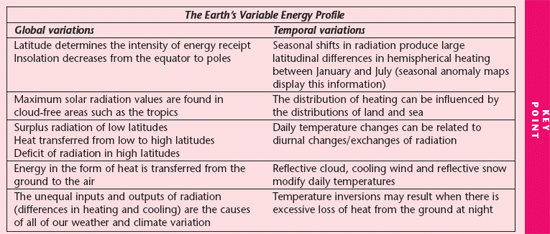Systems & Energy Change
The study of the atmosphere is demanding because of the complexity of the processes and mechanism that power, run and maintain it. For us as humans all the activities vital for life, and to most features in the landscape, occur in the thin layer of the atmosphere that clings to the Earth’s surface because of the ‘pull’ of gravity.
The atmosphere is an open system, with flows or movements of energy and materials between the different parts of the system. The sun is the driving force. The key to understanding the atmosphere is to understand why changes constantly occur in the atmospheric system.
Energy in the atmosphere
Solar radiation, or insolation, occurs as short-wave radiation and is the main source of external (heat) energy input into the Earth’s atmosphere system, while the Earth’s motions and gravitational pull (on air masses and moisture) provides a constant internal source of energy.

The atmosphere is reasonably ‘transparent’ to solar radiation, in that large amounts of energy are allowed to pass through to the ground surface. This stream of energy powers the atmosphere and the biosphere.
About 50% of the insolation received at the edge of the atmosphere is actually ‘lost’. Most is scattered (by dust), reflected (by clouds) or absorbed (by clouds, dust and water vapour). Long-wave radiation emitted by terrestrial and atmospheric radiation is largely absorbed; this contrasts with solar radiation. The balance of the energy receipts is used to heat the ground and air by conduction, convection, turbulence and evaporation.
